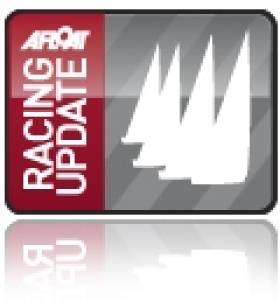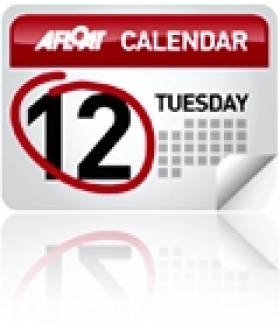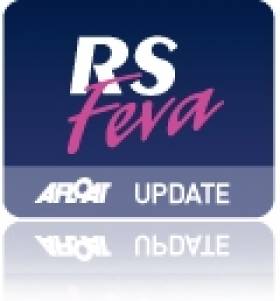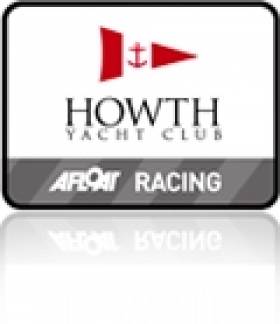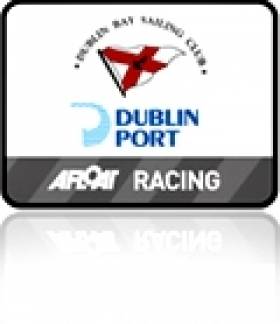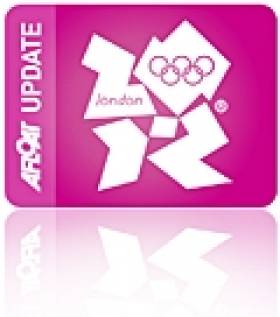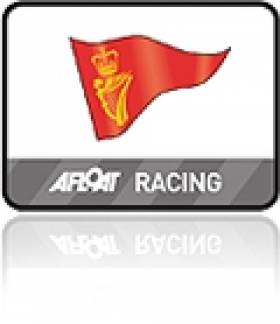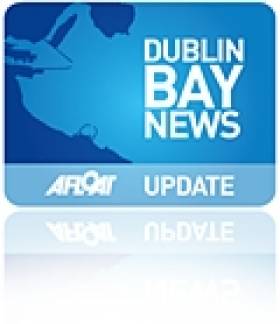Displaying items by tag: Club
Dun Laoghaire Yacht Clubs Voice Concern Over Plan
Dun Laoghaire Yacht Clubs are voicing concerns about the impact on sailing if a 'cruise ship jetty' is constructed as part of the recently published harbour masterplan.
Dublin Bay Sailing Club, Dun Laoghaire Motor Yacht Club, National Yacht Club, Royal Alfred Yacht Club
Royal Irish Yacht Club and Royal St George Yacht Club. are also concerned about access to the water if a proposed 'pedestrian walkway' in front of the waterfront clubs was completed.
The clubs have engaged 'professional help' to prepare a submission to outine the concerns.
Also seen as a problem is the 'lack of sufficient facilities in the masterplan for hosting significant international sailing events'.
A survey in 2009 by the Irish Marine Federation (IMF) calculated a €3million spend by participants connected with the 500-boat Volvo Dun Laoghaire regatta. The clubs have previously stated they see the harbour's future as a leisure facility.
A masterplan model was on display by the Harbour Company in the month of August.
Writing to members in the current edition of the National Yacht Club's newsletter commodore Paul Barrington says the clubs 'hope to further engage with the harbour [company] to find a mutually acceptable way forward'.
Water Rat: Harbour Plan is a Curate's Egg
O'Leary's Set for New York Show Down
Royal Cork's Anthony O'Leary returns to New York's Invitational Cup next week for another crack at the Rolex event that has attracted 22 teams.
Despite no previous experience with the Swan 42, Anthony O'Leary's team from the Royal Cork Yacht Club got off to a blazing start at the 2009 Invitational Cup, scoring a third and two firsts in the opening three races. From there the team rode a bit of a roller coaster with three more top-five finishes, a 13th, and two 17ths. The end result was fifth, a bit disappointing given the quick start, but respectable, nonetheless. More importantly, it earned O'Leary and his team a return invitation.
When racing begins on Tuesday, September 13, at the 2011 New York Yacht Club Invitational Cup presented by Rolex, most of the 22 participating yacht club teams will be fresh from racing at the peak of the sailing season in the northern hemisphere.
Last year, O'Leary was named the Afloat Irish Independent Sailor of the Year for, in part, leading the Irish team to the win at the 2010 Rolex Commodore's Cup."We will continue to sail [the Ker 39] Antix up to mid-season in handicap fleets, as our boat is similar in characteristics to the Swan 42," says O'Leary of his preparations for the Invitational Cup. "Closer to September we will focus more on one-design sailing, which is really the ultimate challenge as shown in the Invitational Cup. Apart from our not finishing on the podium, there was not a single disappointing aspect of the 2009 regatta. The entire event was a great experience, superbly organized by a wonderful club."
O'Leary was still assembling his crew, but it will surely include some family members. Son Peter O'Leary sailed in the 2008 Olympics in the Star class while Nicholas O'Leary, a three-time All-Ireland sailing champion, served as the team's tactician during the 2009 Invitational Cup.
Three teams though – the Cruising Yacht Club of Australia, Royal Cape Yacht Club and Yacht Club Argentino – which hail from below the equator, will be coming from winter to summer to race in Swan 42s for the championship title. "It is an honor for the Yacht Club Argentino (YCA) to participate this coming September," said Commodore Ricardo Galarce. "We are proud of sharing such an important regatta with well-known clubs from different parts of the world.
Besides, it is nice to share with all of them the same objective of competing with fair play and sailing which is what we love doing. We will go to New York Yacht Club's Harbour Court ready to have fun, but we will be doing our best effort to take the cup back to our beloved YCA in Buenos Aires." Galarce explained that even though it is winter in Argentina, the weather is not so cold and the sailors are used to sailing in this season. After the invitation to the event was published in the YCA magazine, any club member who wanted to join the team was encouraged to do so. A team selection was then made taking into account sailing resumes, technical skills and personalities, in order to form a complete, competitive and compatible crew.
Because there was a boat similar to the Swan 42 available for their use in Mar del Plata, the YCA team traveled 400 km to spend a weekend there performing intensive training, "with very good results and lots of learning as regards each of the crew members' functions and movements," said Galarce. "We then carried on our training in Buenos Aires, always trying to sail in boats similar to the Swan 42, which we know is an excellent boat, which demands a lot from its crew." With only two of the crew having previously sailed in Newport – Santiago Braun and Francisco Billoch who each sailed the Onion Patch Series in 1972 – the YCA team is studying the weather forecasts, tides and winds, in order to gain some local knowledge. And the team hopes to become familiar with the Swan 42 in the short time between their arrival and the start of the Invitational Cup. "We know it won't be an easy regatta," concluded Galarce. "We are proud of being able to sail alongside sailors who belong to the most distinguished sailing clubs in the world. We wish them all good luck, and we hope to share great fun on the water."
In Australia where the average sailing temperature for the Cruising Yacht Club of Australia's (CYCA) winter series is 20 degrees Celsius (68 Fahrenheit), sailing is a year-round activity, and all of the CYCA team members race throughout the year in various club events. Most of the CYCA crew that will travel to Rhode Island sailed together for the first time in April on the Corby 49 Vamp in the New South Wales IRC championships, finishing third overall. Vamp then finished second in Division 1 in the recently concluded CYCA Winter series. "None of us have experience in the Swan 42s although most have sailed in similarly equipped and designed yachts over a range of sizes up to the TP52 class," said David Fuller, CYCA Team Manager. "Whereas we have not had many opportunities to sail together, most of our crew have continued to sharpen their skills on other boats in the various races and regattas along the Australian coast and overseas." CYCA tactician Evan Walker is one of those who have been away from Sydney, having recently been at Weymouth, England, to coach an Elliot 6m team at the 2012 Olympic test event.
Before coming to Newport, however, Walker will be racing as tactician in the Cartagena round of the Audi MedCup with an Australian Soto 40 team. "Hopefully the week of sailing as tactician in Spain will have me hitting my straps by the time I arrive in Newport," said Walker, a CYCA Youth Academy graduate who has seen success as a match racing skipper. "I'm very excited to be competing in the Invitational Cup and I'm sure we'll have an enthusiastic team bonding session on our arrival in Newport." David Hudson, skipper of the team from the Royal Cape Yacht Club (RCYC) in South Africa was also at the Olympic test event. "Regarding our preparation for the Invitational Cup, it's obviously not as convenient for us as it would be if the event took place towards the end of our racing season," said Hudson. "However, winter training in Cape Town is perfectly feasible from a weather point of view. At 34 degrees south we have a Mediterranean climate with warm dry summers and cold wet winters, and although we have recently had some snow on the mountains just to the east of our sailing waters, Cape Town seldom gets really cold."
And while none of the RCYC team has any experience racing Swan 42s, they too have been training on a variety of boats of similar size. "We are all looking forward to the challenge," said Hudson. John Martin, RCYC's Commodore and team manager, lived on yachts from the age of eight and cut his teeth in 1971 aboard a new Swan 37 imported to South Africa specifically to do the Cape to Rio race, starting as bowman and working his way back. So it is very apt for him to be sailing a Swan 42 in this regatta, all these years later.
Not only is Martin the most famous yachtsman in South Africa but also he is well-known internationally. "Newport has great memories for me," said Martin. "During my single- and double-handed sailing career, 1981–1991, I had the honor of winning a few races, most importantly, winning the last leg of the 1986/87 BOC Singlehanded Round the World Race which finished in Newport. It is with great delight that I return with a very competent and competitive sailing team to represent the club of which I have been Commodore for the past three years."
An official practice for the 22 yacht club teams will take place on Monday, September 12, from 1300-1700, followed by the opening ceremony for the Invitational Cup. Five days of racing will ensue, with the first warning signal scheduled for 1100 each day.
The winning team will be confirmed at the conclusion of racing on Saturday, September 17. In addition to Rolex, which for 2011 and 2013 is the presenting sponsor, Sperry Top-Sider and Nautor's Swan have also returned, and are joined by Atlantis WeatherGear, as sponsors to enhance the experience of competitors as well as those who will be following the races.
The New York Yacht Club Invitational Cup presented by Rolex NYYC's Harbour Court will host 22 yacht club teams – representing 16 nations from six different continents – with racing on NYYC Swan 42s on Rhode Island Sound and Narragansett Bay from September 10-17, 2011. By country, the roster of participating teams is: Yacht Club Argentino (ARG); Cruising Yacht Club of Australia (AUS); Royal Bermuda Yacht Club (BER); Royal Canadian Yacht Club (CAN); Royal Hong Kong Yacht Club (HKG); Real Club Nautico de Barcelona (ESP); Nyländska Jaktklubben (FIN); Itchenor Sailing Club, Royal Ocean Racing Club and Royal Yacht Squadron (GBR); Norddeutscher Regatta Verein (GER); Royal Cork Yacht Club (IRL); Yacht Club Capri and Yacht Club Punta Ala (ITA); Japan Sailing Federation (JPN); Royal Norwegian Yacht Club (NOR); Clube Naval de Cascais (POR); Royal Cape Yacht Club (RSA); and Eastern Yacht Club (Marblehead, Mass.); Annapolis Yacht Club (Annapolis, Md.); Newport Harbor Yacht Club (Newport Beach, Calif.); and New York Yacht Club (Newport, R.I.) from the USA.
Cullaun Sailing Club Hosts Wayfarer Inlands
On the weekend of the 3rd and 4th of September, Cullaun Sailing club hosted the Wayfarer Inland championships in conjunction with the club's annual mixed fleet regatta.
It was a heart lifting sight to see so many cars in the car park at Cullaun, whilst in the compound there were boats everywhere and a real buzz about the place, and was fantastic to see boats travel from East Down YC, Greystones and Killaloe sailing clubs to support the event , they really brought the event to the next level.
Registration closed at 11am and was immediately followed by the race briefing and by 11.30 the first race promptly kicked off, in all twenty boats took to the water with sailors ranging in age from eleven to seventy one, there was a nice south westerly breeze at the start of the first race, and it didn't take our visitors long to adjust to the quick wind shifts on the inland waters, in particular Tony Fisher and Simon Jeffery ( wayfarer) who set the standard for the weekend by winning the first race, the racing continued in that vein for the day.
By 5pm everyone was off the water, and after stowing the boats it was off to Donellons for a BBQ. Salads arrived in Tupperware boxes and tables laid, the adults began to unwind in the bar and chat of the days events while children picked chestnuts in the garden. As the evening turned to night the music started and the fire stoked. What a glorious day.
Sunday was a shorter day, two races with the intention of finishing at lunch time. The wind was fresh and squally early morning and the scene was set for some exciting sailing, but the wind began to ease as the racing started, Tony and Simon started day two as they had ended day one. Only in the final hour were the pair denied the perfect finish to the regatta when George Jess and Robert Anderson (Wayfarer) took the final race followed by Chris Caher (super Nova) with Fisher/Jeffery paring coming in 3rd.
Results:
Wayfarer Inland Championships
1st Tony Fisher/Simon Jeffery East Down Yacht Club
2nd George Jess/Robert Anderson East Down Yacht Club
3rd Austin Collins/Mike Laffan Cullaun Sailing Club
Best Cullaun boat
Chris Caher in 3rd place overall (Super Nova)
Enterprise Fleet
1st Colm Ward/Lelia O'Shaughnessy Cullaun Sailing Club
2nd Brian Park/Mike Logan Cullaun Sailing Club.
Thanks to all the Volunteers both on and off the water who all helped make this such a successful event, and provide the lifeblood of the club.
In Other News:
The Next event on the calendar will be the beginning of the "Cooler Series" which will start on the 11th of September at 2pm.
The September cruise is on schedule for the weekend of the 17th of September departing Kinsale, two boats and sixteen people are due to set sail, details are being circulated to all those taking part in the event.
A reminder that the laying up supper is taking place in "The Cornstore" limerick on the 26th of November, Sheila is currently taking deposits.
Lift out Scheduled for October 15th
Howth Juniors Win 19-Boat Greystones Feva Event
Seven races were sailed and Howth visitors David Johnston and Louise Flynn Byrne emerged clear winners from Dun Laoghaire's Stephen Judge and Patrick Riordan by a margin of 12 points. Full results here.
Storm Wins Howth IRC Race
Lively Lady Wins DBSC Race on IRC and ECHO
Derek Martin's Beneteau 44.7 Lively Lady produced wins on IRC and ECHO in Dublin Bay Sailing Club's race this afternoon in medium winds that featured a long spinnaker run the length of Dublin Bay. Martin's Royal Irish club mate George Sisk was second on IRC in WOW, a new J122 design. Third was Denis Hewitt in another Royal Irish yacht, Tiamat, a Mark Mills design. Full DUBLIN PORT Dublin Bay Sailing Club Results for 20 AUGUST 2011below:
BENETEAU 31.7 Echo- 1. Attitude (D.Owens/T.Milner), 2. Levante (B.Leyden/M.Leahy), 3. Thirty Something (Gerry Jones et al)
BENETEAU 31.7 - 1. Prospect (Chris Johnston), 2. Thirty Something (Gerry Jones et al), 3. Levante (B.Leyden/M.Leahy)
CRUISERS 0 Echo - 1. Lively Lady (Derek Martin), 2. Tiamat (Denis Hewitt & al), 3. Tsunami (Vincent Farrell)
CRUISERS 0 - 1. Lively Lady (Derek Martin), 2. Wow (George Sisk), 3. Tiamat (Denis Hewitt & al)
CRUISERS 1 - 1. Gringo (Tony Fox), 2. Xtravagance (Colin Byrne), 3. Contango (Barry Cunningham)
CRUISERS 1 Echo - 1. Powder Monkey (C.Moore/M.Byrne), 2. Indecision (Declan Hayes et al), 3. Contango (Barry Cunningham)
CRUISERS 2 Echo - 1. Peridot (Jim McCann et al), 2. Jester (Declan Curtin), 3. Bendemeer (L Casey & D Power)
CRUISERS 2 - 1. Peridot (Jim McCann et al), 2. Jawesome 11 (V.Kennedy/M.Dyke), 3. Bendemeer (L Casey & D Power)
CRUISERS 3 Echo - 1. Gung Ho (G & S O'Shea), 2. Pamafe (Michael Costello), 3. Jammie Dodger (J.H & D.O'Neill)
CRUISERS 3 - 1. Gung Ho (G & S O'Shea), 2. Asterix (Counihan/Meredith/Bushell), 3. Jammie Dodger (J.H & D.O'Neill)
FIREBALL Race 1- 1. Licence to Thrill (Louis Smyth), 2. Goodness Gracious (Louise McKenna), 3. No Name (B McGuire)
FIREBALL Race 2- 1. Licence to Thrill (Louis Smyth), 2. Goodness Gracious (Louise McKenna), 3. Samphire (Marguerite O'Rourke)
FLYING FIFTEEN Race 1- 1. Kooigjug (K Dumpleton), 2. Rollercoaster (Tom Murphy), 3. Deranged (C.Doorly)
FLYING FIFTEEN Race 2- 1. Mellifluence (Tom Leonard), 2. Deranged (C.Doorly), 3.Frequent Flyer (D Mulvin)
GLEN - 1. Glenluce (D & R O'Connor), 2. Pterodactyl (R & D McCaffrey), 3. Glenshesk (L.Faulkner et al)
IDRA 14 FOOT Race 2- 1. Dunmoanin (Frank Hamilton), 2. Squalls (Stephen Harrison), 3. Doody (J.Fitzgerald/J.Byrne)
IDRA 14 FOOT Race 1- 1. Squalls (Stephen Harrison), 2. Dunmoanin (Frank Hamilton), 3. Dart (Pierre Long)
MERMAID Race 1- 1. Jill (P.Smith/P.Mangan), 2. Aideen (B.Martin/D.Brennan), 3. Kim (D Cassidy)
MERMAID Race 2- 1. Jill (P.Smith/P.Mangan), 2. Kim (D Cassidy), 3. Aideen (B.Martin/D.Brennan)
PY CLASS Race 1- 1. P Keane (Laser 1), 2. N O'Toole (Laser), 3. R Tate (Laser)
PY CLASS Race 2- 1. Yvonne Gordon (Laser Radial), 2. R Tate (Laser), 3. Desmond McCarthy (Laser 1)
RUFFIAN 23 - 1. Diane ll (Bruce Carswell), 2. Ruff N Ready (Ann Kirwan et al), 3. Alias (D.Meeke/M.McCarthy)
SHIPMAN - 1. Whiterock (Henry Robinson), 2. Gusto (C Heath), 3. Curraglas (John Masterson)
SIGMA 33 - 1. White Mischief (Timothy Goodbody), 2. Leeuwin (H&C Leonard & B Kerr), 3. Pippa lV (G.Kinsman/K.Blake/M.O'Brien)
SQUIB Race 2- 1. Kookaburra (P & M Dee), 2. Nimble (Brian O'Hare), 3. Little Bird (N Barnwell)
SQUIB Race 1- 1. Why Not (Derek & Jean Jago), 2. Little Bird (N Barnwell), 3. Nimble (Brian O'Hare)
WHITE SAIL CRUISERS Echo- 1. Zephyr (R Cahill-O'Brien), 2. Arwen (Philip O'Dwyer), 3. Nirvana (Bernard Neeson)
WHITE SAIL CRUISERS - 1. Arwen (Philip O'Dwyer), 2. Vespucci (S & K O'Regan), 3. Zephyr (R Cahill-O'Brien)
British Olympic Gold Medallists to Contest Dun Laoghaire Event
Olympic trial winners Royal Cork's Peter O'Leary crewed by Malahide's David Burrows, who finished fourth at the Pre-Olympic regatta in Weymouth a week ago, lead a home challenge in a fleet that contains the current Olympic champion, four past world champions and seven continental class champions.
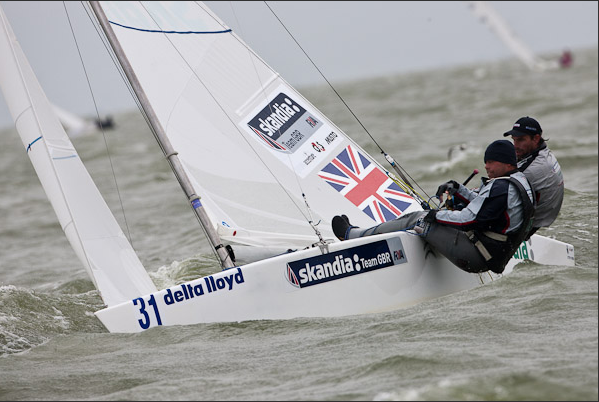
British Olympic Gold Medallists Percy and Simpson are coming to Dublin Bay next month. Photo: Delta Lloyd Regatta /Sander van der Borch
Beijing Gold Medalists, Britain's Ian Percy and Andrew Simpson, are confirmed for the presitgious Olympic class event that starts at the Royal St. George YC on September 2nd.
Ireland's other entry is Olympic triallists Max Treacy and Anthony Shanks from the host club.
The entries for the 2011 Star European Championships are:
| Skipper | Country | Sailing Number |
|---|---|---|
| Chatagny | CH | SUI 8075 |
| Niklaus Michel | CH | SUI 7829 |
| Alexander Schlonski | DE | GER 8426 |
| Maxwell Treacy | IE | IRL 8381 |
| Mateusz Kusznierewicz | PL | POL 8417 |
| DENIS KHASHINA | UA | UKR 8205 |
| Andrew Campbell | US | 8423 |
| Ante Razmilovic | UK | 8191 |
| Johannes Polgar | Germany | 8414 |
| Arthur Anosov | UKR | 8240 |
| Andrey Berezhnoy | Russia | 8359 |
| Barbara Beigel Vosbury | 7986 | |
| Fernando Echavarri | Spain | 8209 |
| Flemming Soerensen | Danish | 8225 |
| George Szabo | US | 8434 |
| Guillaume Florent | France | 8270 |
| Lev Shnyr | Russia | 8047 |
| MARIN LOVROVIC | Croatia | 8339 |
| Pavlo Bondar | UKR | 8119 |
| Tom Londrigan, Jr. | US | 8170 |
| Vasyl Gureyev | UKR | 8247 |
| Xavier ROHART | France | 8237 |
| Mate Arapov | 7287 | Croatia |
| Richard Clarke | 8361 | Canada |
| Stuart Hebb | 8427 | Canada |
| Tom Lofstedt | 8351 | Sweden |
| Diego Negri | 8266 | Italy |
| Peter O'Leary | 8418 | Ireland |
| Tibor Tenke | 8386 | Hungary |
D-Tox on Form in O'Leary Insurance League
Results Summary:
1st in White Sail IRC Micheal Lynch's Sun Odyssey 32i "Lady T"
1st in White Sail Echo Micheal Lynch's Sun Odyssey 32i "Lady T"
1st in Class 3 IRC Jimmy Nyhan & Maritta Buwalda's 1/4 Tonner "Outrigger"
1st in Class 3 Echo Tom & Cormac MacSweeney's Sigma 33 "Seascapes"
1st in Class 2 IRC Paul & Deirdre Tingle's First 31.7 "Alpaca"
1st in Class 2 Echo Leonard Donnery's Nicholson 33 "No Gnomes"
1st in Class 1 IRC Donal O'Leary's X35 "D-Tox"
1st in Class 1 Echo Frank Doyle's A35 "Endgame"




























